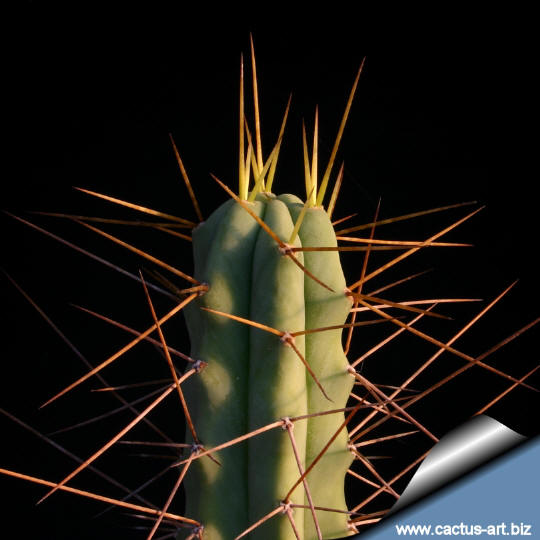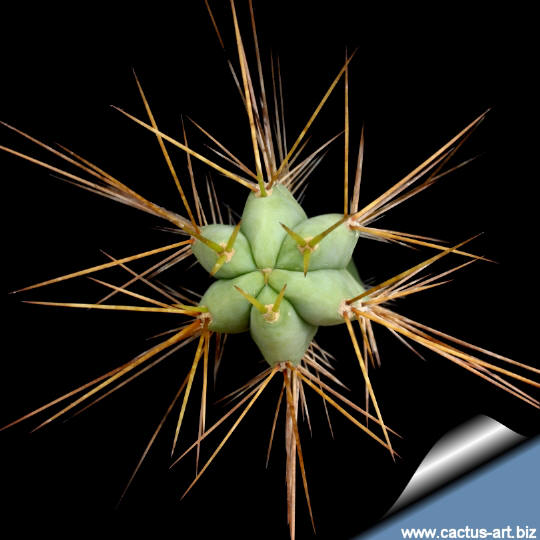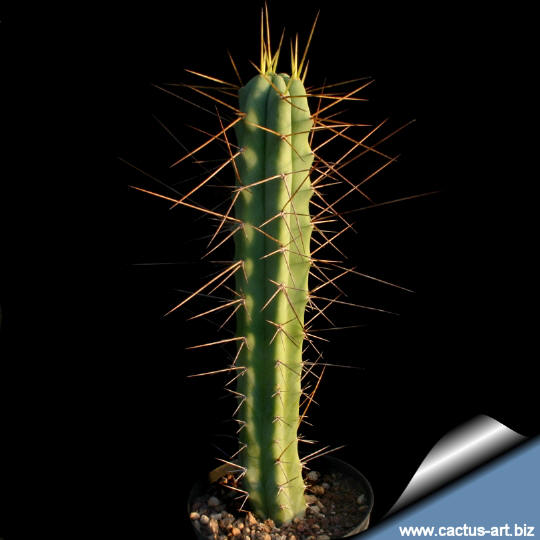|
|
|

Trichocereus bridgesii
Easily recognizable for its formidable drooping 4-10 cm long
spines.
Like it's
relatives, this
species is a quick grower and is reported to
grow up to 6m in height.
|
 |
Description: It is a fast-growing columnar
cactus , branching at the base that can grow 2–5 (-6) m tall
with stems of up to 15–20 cm in diameter.
Stem: Upright light glaucous green coloured, , dark green in age.
Ribs: 4 to 8 ribs (usually 5-7), broad at base, obtuse, with a
more or less deep horizontal depression above the areole
Spines: Honey-coloured to brown, located on the nodes in groups
of up to 4. They can grow up to 6–7 8-(-10) cm in length and in fully
grown plants are spaced evenly on the ribs, 2.5 to 3 cm apart.
Flowers: Very large, night blooming, fragrant, white up to 20 cm
in diameter. Flowers tube and fruit covered with scales and black curled
hairs.
Blooming time: Summer. |
There exist several mutant varieties of this
T. bridgesii that are highly prized by cactus impassioned. These
include a cristate variety, a variegated variety and two variants of
monstrous growth (Clones A
and B), Of the monstrous varieties, one (Clone B) is often known by the
name Penis Plant.
Two more recently developed clones are now available, the fist of which
exhibits both monstrous and cristate growth whilst the second shows both
monstrous and variegated growth.
Propagation:
Cutting or from seed. The seeds are quite easy to germinate and grow.
Their main requirements consist of high humidity levels, free-draining
soil mix, and enough water, light, and nutrition
UTILIZATION:
- Grafting stock:
Along with
T. pachanoi
(that
is commonly suggested as a universal
grafting stock) T. bridgesii work well and have a good success
rate for lasting a long time. Scions grafted on Trichocereus
might initially take slightly longer to begin their growth burst (when
compared to other grafting stocks), but usually have a very good life
span of steady fast growth.
- Defense: Trichocereus bridgesii in
Bolivia is grown both as a hedge plant and placed on top of walls as
protection for gardens. In fact the spines are very efficient at
deterring theft or animals.
- Psychoactive effect: The Trichocereus
bridgesii has a long shamanic tradition of use throughout
its homeland in the high Bolivian deserts where it is sometimes called
achuma or wachuma. The mescaline content is very close to san pedro
(about 2% in dry samples), but some individual Trichocereus
bridgesii plants have a mescaline content that exceeds that of san
pedro (Trichocereus pachanoi). Trichocereus bridgesii
is often cultivated indoors for it's powerful and protective spirit.
|
|
Photo of conspecific taxa, varieties, forms and
cultivars of Trichocereus bridgesii.
|
|
Advertising
|
|
|
|
|
Family:
Cactaceae (Cactus
Family)
Scientific name: Echinopsis bridgesii (Britton & Rose) H.
Friedrich & G. D. Rowley 1974
Conservation status: Listed in
CITES appendix 2.
Synonyms: Echinopsis lageniformis
Note: Echinopsis
bridgesii Salm-Dyck (not to be confused
with E. lageniformis, which is also known as Trichocereus
bridgesii )
Origin: Bolivia (La Paz)
Habitat: It grows naturally in the high altitude, high
rainfall areas of the Andes, it can withstand temperatures far below
that of many other cacti.
|

Trichocereus bridgesii looks a lot like the
Trichocereus pachanoi, but it has much longer menacing spines and
has a bit more a bluish/greyish colour in stead of the clear green
colour of the Trichocereus pachanoi.
|
|
|
|

Cultivation:
Trichocereus bridgesii is very easy to grow and cold hardy as low as
-12°C (or less). Need a fertile, well drained soil mix. Water the plants
well and allow them to dry before watering again. This species seems to
do better with a little more water than most cacti. In fact, its
cultivation requirements are really more like 'normal' plants than most
other cacti. During the growing season fertilize them monthly with a
balanced fertilizer
Sun Exposure: Outside
full sun, but during hot summers, the cactus are subject to sun
burning, so grow them in light shade, inside needs bright light, and
some direct sun.. During winter month, put them in a cool luminous place
and encourage them to enter winter dormancy by withholding water and
fertiliser over the winter as they will etiolate, or become thin, due to
lower levels of light. They are susceptible to fungal diseases if
overwatered, but are not nearly as sensitive as many other cacti,
especially in warm weather. They tend characteristically towards black
rotted spots unless watering is moderate and only in hot weather, if
kept damp through cold periods, they will invariably suffer.
T. bridgesii produces prodigious amounts of growth each year if
kept well fed and watered throughout the warmest months, particularly if
it has been acclimatised to accept full sun. Once this cactus is
established it can easily produce 30cm of growth every year.

 |
|